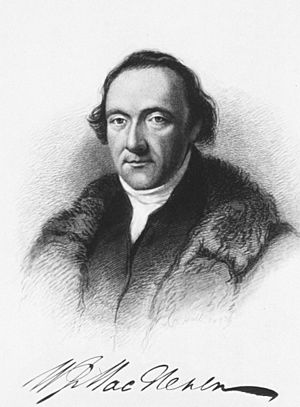William James MacNeven facts for kids
Quick facts for kids
William James MacNeven
|
|
|---|---|
 |
|
| Born | 21 March 1763 Aughrim, County Galway, Ireland
|
| Died | 13 July 1841 (aged 78) New York City, United States
|
| Nationality | Irish |
| Occupation | physician |
William James MacNeven (sometimes spelled MacNevin or McNevin) was an important Irish doctor. He was born on March 21, 1763, near Aughrim, County Galway, Ireland. He later had to leave his home country because he was involved with a group called the United Irishmen. This group worked for more rights and a better government for Ireland.
After moving to the United States, MacNeven became a strong supporter of freedom for all people, no matter their religion. He is even known as the "father of American chemistry." He passed away on July 12, 1841, in New York City. You can find an old monument dedicated to him near St. Paul's Chapel in New York. Another monument nearby honors Thomas Addis Emmet, who was also a United Irishman.
Contents
Early Life and Education
William James MacNeven was the oldest of four brothers. When he was 12, his uncle, Baron MacNeven, sent him to study abroad. At that time, laws in Ireland made it very hard for Catholics to get an education. His uncle, William O'Kelly MacNeven, was also a doctor who had become an Austrian noble.
Young MacNeven studied at Prague and then went to Vienna for medical school. He learned from a famous professor named Pestel and earned his medical degree in 1784. That same year, he returned to Dublin to start his medical practice.
Fighting for Irish Rights
MacNeven joined the Catholic Committee, a group working for Catholic rights. In 1792, he became a delegate to the Catholic Convention. Here, he worked with leaders like Wolfe Tone to push for full rights for Catholics.
He also joined the United Irishmen, a group that wanted a fair government for Ireland. They aimed to unite Catholics and Protestants. MacNeven took an oath to support this goal. He worked with other leaders, like Oliver Bond, to ask France for help in their fight for an independent Ireland.
In March 1798, after returning from Paris, MacNeven was arrested and held in Kilmainham Jail. After the rebellion was stopped, he was moved to Fort George, Scotland, as a prisoner. He was released in 1802, but only if he agreed to leave Ireland.
The next year, he went to Paris to help Robert Emmet convince Napoleon Bonaparte to send troops to Ireland. MacNeven even joined the Irish Legion as a captain. However, after Emmet's uprising failed in Dublin in 1803, MacNeven lost hope in Napoleon. He decided to move to the United States, like many others from the Irish Legion.
Life in the United States
William James MacNeven arrived in New York on July 4, 1805. He started practicing medicine again. He also continued to speak out about Irish issues.
In 1807, he published a book called Pieces of Irish History. This book included essays by him and Thomas Addis Emmet, along with important papers about the United Irishmen. MacNeven wanted to correct wrong information spread by those who opposed the Irish cause. He explained that seeking French help was a practical choice, similar to how American leaders sought help from France during their own revolution.
Later, MacNeven realized that using force might no longer be the best way to achieve change in Ireland. He believed in the peaceful changes happening there.
Contributions to Science and Society
In 1807, MacNeven began teaching clinical medicine at the College of Physicians and Surgeons in New York. In 1808, he became a professor of midwifery. By 1810, he was teaching chemistry, and in 1816, he also taught materia medica (the study of medicines). In 1823, he was chosen to join the American Philosophical Society, a group of important thinkers.
In 1826, MacNeven and some colleagues left their positions due to a disagreement. He then became a professor at Rutgers Medical College, which was a new school in New York. This school became popular because of its great teachers, but it closed after four years.
MacNeven also worked with William Sampson to create the Society of Friends of Religious and Civil Liberty. In 1829, during a meeting on St Patrick's Day, MacNeven connected the fight for Catholic rights to the cause of ending slavery. He told the group that they were meeting for the same reason "good men of all nations" spoke out against the enslavement of Africans.
William James MacNeven is lovingly called "The Father of American Chemistry" because of his important work. He is buried on the Riker Farm in Queens, New York. The obelisk at St. Paul's Chapel's graveyard is a monument to him, not his burial site.
Family Life
On June 15, 1810, MacNeven married Jane Margaret Riker Tom. She was the widow of a merchant named John Tom and the daughter of U.S. Representative Samuel Riker. William and Jane had several children together.
Published Works
One of MacNeven's most famous scientific works is his "Exposition of the Atomic Theory" (1820), which was even reprinted in a French science journal. In 1821, he helped publish an updated version of Brande's "Chemistry."
He also wrote several non-scientific books, including "Rambles through Switzerland" (1803) and his important "Pieces of Irish History" (1807). He also wrote many political essays that gained wide attention. For many years, he was a co-editor of the "New York Medical and Philosophical Journal."

